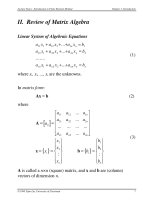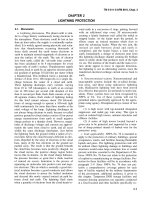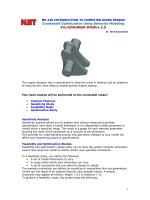CHAPTER 2. ENZYMES ppt
Bạn đang xem bản rút gọn của tài liệu. Xem và tải ngay bản đầy đủ của tài liệu tại đây (3.05 MB, 94 trang )
1
CHAPTER 2. ENZYMES
INTERNATIONAL UNIVERSITY
SCHOOL OF BIOTECHNOLOGY
BIOCHEMISTRY
2
Learning objectives
1. Comprehend how enzyme kinetics relates to
the chemical kinetics presented in general
chemistry courses.
2. Perceive how kinetic parameters are
experimentally determined.
3. Learn the Michaelis–Menten equation and
the meaning of K
M
and V
max
.
4. Understand the enzyme kinetics
3
Brief Content
1. WHAT IS ENZYME?
2. CLASSIFICATION OF ENZYME
3. PROPERTIES OF ENZYME
4. ENZYME KINETICS
5. CATALYSIS (assignment)
6. ENZYME REGULATION (assignment)
4
Detailed Content
1. WHAT IS ENZYME?
2. PROPERTIES OF ENZYME
3. CLASSIFICATION OF ENZYMES
4. ENZYME KINETICS
Michaelis- Menten kinetics
Lineweaver Burk plots
Enzyme inhibition
5. CATALYSIS
Catalytic mechanisms
The role of cofactor in enzyme catalysis
Effects of temperature and pH on enzyme-catalyzed reactions
Detailed mechanisms of enzyme catalysis
6. ENZYME REGULATION
Covalent modification
Allosteric regulation
5
1. WHAT IS ENZYME?
The most important functions of enzyme is
their role as catalyst. All enzymes were
considered to be protein but some examples
of RNA molecules can also be catalyst.
Living processes consists almost entirely of
biochemical reactions. Without catalysts
these reactions would not occur fast enough
to sustain life.
6
How a biochemical reaction can happen?
A reaction happens need the energy to
vibrate the molecules and the reactant
concentration enough. The energy here is
often provided by heat.
However, in living system, high temperature
may harm the biological structure
Truly that the concentration in living system
is very low. So living organisms solve these
problems by using enzyme
7
Which properties help enzyme a biocatalyst
1. The rates of enzymatically catalyzed
reactions are often phenomenally high
2. The enzyme are highly specific to the
reaction
3. Enzyme has the complex structures so it
can be regulated
8
2. PROPERTIES OF ENZYMES
The active site
Activation energy
Cofactor
9
3. CLASSIFICATION OF ENZYMES
There are the six major enzyme categories:
1. Oxidoreductases: Oxidoreductase
catalyze oxidation-reduction reactions.
Subclasses of this group include the
dehydogenases, oxidases, oxygenases,
reductases, peroxidase, and hydroxylases
10
2. Transferases
Transferases catalyze reactions that involve
the transfer of groups from one molecule to
another such as amino, carboxyl, carbonyl,
methyl, phosphoryl, and acyl (RC=O) and the
enzyme names often go with trans such as
transcarboxylase, transmethylase, and
transaminases
11
3. Hydrolases: Hydrolases catalyze reaction
in which the cleavage of bonds is
accomplished by adding water
Hydrolases include the esterases,
phosphatase, and peptidase
12
4. Lyases: Lyases catalyze reaction in which
groups H
2
O, CO
2
, and NH
3
are removed to
form double bond or are added to a double
bond.
Examples: Decarboxylases, hydratases,
deaminases, and syntases
13
5. Isomerases: This is a heterogeneous
group of enzyme. Izomerases catalyze
several types of intramoleucular
rearrangements. The epimerases catalyze
the inversion of a symmetric carbon atoms.
Mutases catalyze the intramolecular transfer
of functional groups
14
6. Ligases: Ligases catalyze bond
information between two substrate
molecules. The energy for the these reaction
is always supplied by ATP hydrolysis. The
name of many ligases include the term
synthetase several other ligases are called
carboxylase
15
Enzyme kinetics
Kinetics is the study of the rates of chemical
reactions. For any reacting system, thermodynamics
can be used to predict whether the reaction will
spontaneously occur. The kinetics of the reaction
indicate how fast the reaction actually goes. Most of
the biological reactions that occur in the cells of
living organisms are greatly sped up by protein
catalysts called enzymes. Recall that catalysts
dramatically increase the rate of a reaction without
affecting the equilibrium.
16
17
Enzyme kinetics
ELEMENTARY KINETICS
Our first objective for this exercise is to show how
enzyme kinetics relates to the elementary kinetics
you studied in General Chemistry.
Let’s begin with a simple reaction, a unimolecular
reaction that can be described as A being converted
into B.
A B
18
19
20
21
Enzyme kinetics
Recall that since there is only one reactant, this is a first order
reaction whose rate, or velocity, can be described as the
disappearance of the reactant over time or the appearance of
the product over time. The reaction rate is represented by the
slopes of these lines and is not constant. For this first-order
reaction, the rate is directly proportional to the concentration of
reactant. Here K is the first-order rate constant for the reaction.
Although the rate constant does not change, the velocity of the
reaction begins to decrease as the concentration of the
reactant diminishes and the product accumulates. The rate of
the reaction eventually slows to zero as the product of the initial
forward reaction becomes a reactant for the reverse reaction.
Equilibrium is the pointwhere the forward and reverse reaction
rates are equal, and the overall rate of the reaction is zero.
22
23
Enzyme kinetics
In a simple enzyme-catalyzed reaction, the reactants
are labeled S for substrates and products are
labeled P. This looks like our first example, a simple
first-order reaction in which substrate is converted to
product. Similarly, the rate of an enzyme-catalyzed
reaction is either the disappearance of the substrate
or the formation of the product over time. As the
reaction proceeds, the reverse reaction begins to
compete with the forward reaction until the rates are
equal, and equilibrium has been reached.
24
25
Enzyme kinetics
The rate equation for a enzyme-catalyzed reaction
with a single substrate is the same as the rate
equation for the simple nonenzymatic reaction, but
only when the concentration of substrate is so low
that the enzyme has very little chance to convert it to
product. Under these unique conditions, it appears
that the reaction is first order with respect to
substrate. However, this special case is much too
limiting and rarely applies in biological and
experimental systems. Consequently, biochemists
must use a different model to describe the kinetics of
biological reactions catalyzed by enzymes.









